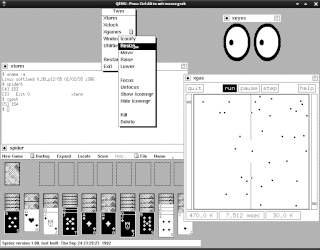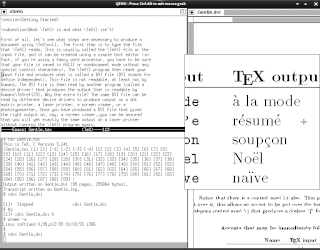Mike's Mathom Collection - Linux History
My start with Linux

As a grad student in 1990, I bought my first PC (386 + 387 math coprocessor and 16 MB of memory, which was absolutely huge), but I couldn't believe how wimpy DOS was at the time. I had always used some flavor of Unix in the university, so DOS seemed like a huge step backward. As a starving grad student, however, I couldn't afford one of the commercial Unices, so the dream of Unix on my PC had to wait. I heard about Linux in the Spring of 1992, but since I was trying to finish my PhD, I held off a few months. However, within a week of defending my dissertation and moving to California in November, 1992, I nuked my 386's hard drive and started tinkering with the Linux bootdisk/rootdisk install, the MCC distribution, then finally the SLS distro.
SLS Linux was the first “complete” Linux distribution and I was able to get it into a very workable state on my machine. It had the linux-0.98p5 kernel, the “usual” GNU tools, networking, and the X11 display system all in one place. While it had a reputation for being buggy, it worked beautifully for me and felt like home; I've been using Linux at work and at home ever since.
In proof of the fact that nothing that appears on the Internet can ever be deleted, there are a few newsgroup posts that I either made or saved in 1992 and 1993, which, if nothing else, show I was dabbling in Linux early on. The earliest indirect evidence I have is a post I saved (and I still have) in preparation to configure my graphics card to run X11. Greg Galloway posted to comp.os.linux (and comp.unix.bsd) on October 20, 1992, detailing his findings on configuring a graphics card that was from the same manufacturer as the card I had (though his was an earlier model). I thought it worth keeping for my upcoming installation.
The earliest direct evidence I can find is the following set of messages that is contained at the ibiblio archive (amongst a number of other locations); the oldest message is contained in Volume 4, digest17 (in Linux-V4-0XX.tar.z, which is a gzipped tar archive file).
The first post is a query I made in January 1993 about why the bootloader wasn't recognizing my dual-boot Linux and DR-DOS setup properly:
From: ressler@hardy.ipac.caltech.edu (Mike "IR" Ressler) Subject: LILO 0.7 can't boot DOS (?) Date: 13 Jan 1993 05:59:47 GMT
I got a response from Stephen Tweedie (and a number of other direct emails) which correctly pointed out the issue and I was off and running. Stephen later helped develop the ext2 filesystem and then led the ext3 filesystem development. He has a bio page on Wikipedia. Wow!
From: sct@dcs.ed.ac.uk (Stephen Tweedie) Subject: Re: LILO 0.7 can't boot DOS (?) Date: 14 Jan 93 17:18:05 GMT
The graphics card in my PC was a Diamond Speedstar 24, notorious at the time for Diamond's refusal to provide clock parameter specs, thus those of us that had one had to reverse engineer everything. I was able to get it to work just fine in a 1024x768x8-bit mode, but getting the 640x480x24-bit mode was defeating me. I can't remember if I ever did get it to work, but here is my query.
From: ressler@hardy.ipac.caltech.edu (Mike "IR" Ressler) Subject: Has anyone done 24-bit color in Linux? (with Speedstar 24) Date: 1 Feb 1993 03:57:54 GMT
Shortly after that, I inquired about using Linux as controller for an infrared astronomical camera I was working on. I got several responses by email encouraging me to go for it, and thus my ground-based mid-infrared camera “MIRLIN” was born. It traveled to the Palomar 200″ telescope, the NASA Infrared Telescope Facility, and the Keck II telescope (the latter two on Mauna Kea, Hawaii) from 1994 through 2002, with an occasional run at Palomar until it was informally retired in 2006. While it's original webpage is no longer available, a few links to some of the science results are given after the newsgroup post.
From: ressler@hardy.ipac.caltech.edu (Mike "IR" Ressler) Subject: Linux as an Infrared Camera Controller Platform???? Date: 18 Mar 93 02:05:18 GMT
- Discovery of a debris disk around HR 4796
- The press release for the HR 4796 discovery
- Images of the Galactic Center
What did Linux look like back then? While I've never been able to find a copy of sls-0.98pl5 online, I have found a not-much-later 0.99pl2, and have been able to successfully run it under qemu. Unfortunately, qemu doesn't have a video emulator that SLS will recognize, so the best I can do is mono-mode (832x624x1-bit - the biggest legal 4:3 screen that can be packed into 64K video memory!). The first screengrab shows a few basics and toys; the second shows a LaTeX session. Yes, I really did use that back then (and still today).
 |
 |
| Basic SLS-0.99pl2 screen showing a pulldown menu, xterm, xeyes, spider, and xgas. | An emacs and TeX session showing a preview of “A Gentle Introduction to TeX.” |
A number of very old Linux distributions (including the one from which I created the qemu image shown here) are available at www.oldlinux.org.
 |
Graphics files (JPEG or PNG), unless otherwise credited. If you would like to use something, just ask! |
 |
All other files (.html, .pdf, etc.) |